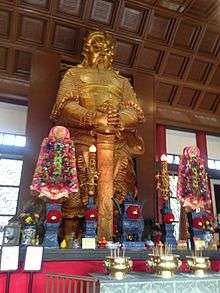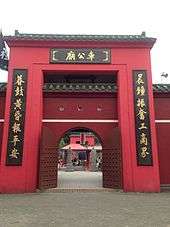The Birthday of Che Kung

Che Kung festival or the Birthday of Che Kung is the day when people celebrate the birth of Che Kung. On this day, people, especially Hongkongers, would like to go to Che Kung Temple and worship Che Kung. Che Kung was a military commander in Southern Song dynasty. He protected the Emperor Bing of Song to escape Mongol invaders and considered as loyalty to the emperors.
The real birthday of Che Kung is 2 January in the Chinese lunar calendar. Nevertheless, people prefer the next day to celebrate his birthday.
Procedures of the festival celebration


They are:[1]
- Preparing of the offerings, they may include: incense sticks, red candles, fresh fruits, flowers, meats and any other Chinese New Year food.
- Hitting the ‘Drum of heaven’ (天鼓) to inform Che Kung the worshiper has come.
- Placing the offerings in front of the statue of Che Kung, and then lighting up the candles and burning the incense sticks.
- Telling Che Kung your personal information and wishes while offering the incense in the main hall.
- Burning the paper clothes, paper money and other paper offerings to Che Kung in the assigned area.
- Spinning the golden pinwheel with your left hand outside the temple clockwise if you think you had good luck last year and you want to keep it in the coming year; otherwise, if you had bad luck last year and you want it to be good in the coming year, you should spin the pinwheel anti-clockwise.
- Buying your personal pinwheel and placing it in a position that abides by the principles of Feng Shui.
- Returning to the temple and giving offerings to Che Kung in thanks to him for taking care of you throughout the prior year.
Apart from the ceremony carried in the above hall, there are other practices to be done in the subordinate halls e.g. Tai Sui (太歲), Cai Shen(財神). For believers who are students, they often write down their name and wishes on a praying paper, and stick it onto a board called Jinbang timing board (金榜題名板) to pray for better academic achievements. To express their respect to Che Kung, believers may donate to the temple (添香油). Divination (求籤) is also practised in Che Kung Temple as a way of fortune-telling.
Popularity and its believers
On the Che Kung festival in 2014, 65 thousand people went to Che Kung.[2] Believers think practising divination in Che Kung temple has made accurate predictions in the past. The first time was in 2003, Minister of Home Affairs Dr Patrick Ho Chi-ping on behalf of the city pulled out the worst possible bamboo stick in the temple on the Birthday of Che Kung. In the same year, Hong Kong was hit by the severe acute respiratory syndrome (SARS) outbreak.[3]
Therefore, the person on behalf of Hong Kong practising divination on the Birthday of Che Kung has changed to Lau Wong Fat, the minister of Heung Yee Kuk since 2004.
The Birthday of Che Kung also relates to some political controversy. In the event of Hong Kong Express Rail Link controversy, about 20 post-80s generation anti-rail representatives joined the Hong Kong Government Lunar New year kau cim tradition at Che Kung temple, Sha Tin to draw three divination sticks as a way of demonstration to express their anger towards Hong Kong government.[4]
Ritual Meanings
Purpose of the ceremony and date selection

Che Kung is famous for his power to suppress chaos and his supreme ability to cure diseases. Precisely because of the abilities of Che Kung, he was soon revered as a "God" and has been considered as a "God of protection". Consequently, his followers and worshipers constructed a temple specifically for Che Kung in order to praise his power and good deeds.
Moreover, there are four festival seasons of Che Kung’s birthday in Lunar Calendar (including 2/1, 27/3, 6/6 and 16/8). Since the first festival season falls on the Lunar New Year holiday, believers have dedicated the third day of the Lunar New Year as an annual event to worship Che Kung, and the celebration is known as "The Birthday of Che Kung" nowadays.
Meanings behind the objects used
Devotees choose to burn incense sticks. Burning incense sticks is a common phenomenon during the festival, because the process of burning incense sticks and the rising smoke symbolizes the appreciation of the devotees to the blessing and protection from Che Kung of the previous year. Devotees would also tell their living problems to Che Kung and hope that he will fulfill their wish. It is believed that their wishes will be carried up to heaven to Che Kung by the smoke of the incense.
Pinwheels can always be found next to the effigy of Che Kung, and they are regarded as ‘a wheel of fortune’. It is believed that the one who turns the pinwheel will be granted with prosperity and good luck for the entire year.
Reflection of Chinese cultures/values

In Chinese culture, worshiping Che Kung is similar to worshiping Guandi,[5] a god widely worshiped within Chinese communities as they believe he protects the entire nation. Both of them were generals protecting their country and demonstrated the loyalty to the motherland and to the people. Hong Kong local residents believe that Che Kung would protect them and their villages as he protected the Song dynasty. Being deeply influenced by Confucianism, Chinese people admire the bravery and uprightness of Che Kung.
On the 3rd of First Month in Lunar Month, traditionally, Chinese people think it is easy to have an argument with other people and this will give them misfortune. To prevent this curse from happening, Chinese people would like to worship folk god(s). That is the reason why so many people choose this day to go to worship Che Kung and pray for their fortune in the following year.
See also
References
- ↑ 李丞責:新春吉祥開運法, 東週刊, http://eastweek.my-magazine.me/index.php?aid=10494, Retrieved from 3/4/2014
- ↑ 赤口拜車公 人數大跌6成(n.d. 2014) http://hk.apple.nextmedia.com/realtime/news/20140202/52149732
- ↑ A.Wu(2013).It's time for Hong Kong to make its own luck,SCMA, http://www.scmp.com/comment/insight-opinion/article/1152450/its-time-hong-kong-make-its-own-luck
- ↑ 80後為社區家園求得下籤(n.d 2010), The Sun, http://the-sun.on.cc/cnt/news/20100216/00407_007.html
- ↑ Superscribing Symbols: The Myth of Guandi, Chinese God of War, Duara.P(1988), JSTOR http://www.jstor.org/stable/2057852
Further reading
- Ward, Barbara and Joan Law. Chinese Festivals in Hong Kong. ISBN 978-9622173040.
- Chan, Sui-Jeung. Calendar of Traditional Chinese Festivals and Local Celebrations.
External links
- Discover Hong Kong
- Sourcewire: Celebrate Che Kung's Birthday in Hong Kong
- Hong Kong Fast Facts: Che Kung's Birthday